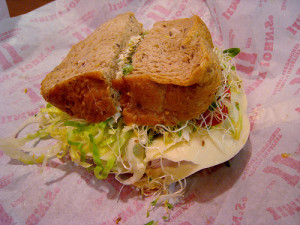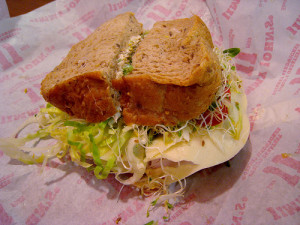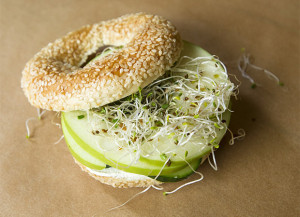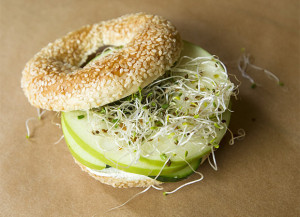After a series of outbreaks associated with sprouts in the mid-1990s, the U.S. Food and Drug Administration (FDA) published guidelines in 1999 for sprouts producers to reduce the risk of contamination. The recommendations included treating seeds with an antimicrobial agent such as calcium hypochlorite solution and testing spent irrigation water for pathogens.
 From 1998 through 2010, 33 outbreaks from seed and bean sprouts were documented in the United States, affecting 1330 reported persons. Twenty-eight outbreaks were caused by Salmonella, four by Shiga toxin–producing Escherichia coli, and one by Listeria. In 15 of the 18 outbreaks with information available, growers had not followed key FDA guidelines. In three outbreaks, however, the implicated sprouts were produced by firms that appeared to have implemented key FDA guidelines.
From 1998 through 2010, 33 outbreaks from seed and bean sprouts were documented in the United States, affecting 1330 reported persons. Twenty-eight outbreaks were caused by Salmonella, four by Shiga toxin–producing Escherichia coli, and one by Listeria. In 15 of the 18 outbreaks with information available, growers had not followed key FDA guidelines. In three outbreaks, however, the implicated sprouts were produced by firms that appeared to have implemented key FDA guidelines.
Although seed chlorination, if consistently applied, reduces pathogen burden on sprouts, it does not eliminate the risk of human infection. Further seed and sprouts disinfection technologies, some recently developed, will be needed to enhance sprouts safety and reduce human disease. Improved seed production practices could also decrease pathogen burden but, because seeds are a globally distributed commodity, will require international cooperation.
Outbreaks caused by sprouts, United States, 1998–2010: lessons learned and solutions needed
Foodborne Pathogens and Disease, Volume: 11 Issue 8: July 30, 2014, Pages 635-644
DechetAmy M., HermanKaren M., Chen ParkerCary, TaorminaPeter, JohansonJoy, TauxeRobert V., and MahonBarbara E.
http://online.liebertpub.com/doi/abs/10.1089/fpd.2013.1705
Raw sprouts are the poster child for failures in what academics call, risk communication.
I’ve been thinking about this for a long time.
 About 1999, graduate student Sylvanus Thompson started working with me on risk analysis associated with sprouts. He got his degree and went on to rock-star status in the food safety world with the implementation of the red-yellow-green restaurant inspection disclosure program with Toronto Public Health, but we never published anything.
About 1999, graduate student Sylvanus Thompson started working with me on risk analysis associated with sprouts. He got his degree and went on to rock-star status in the food safety world with the implementation of the red-yellow-green restaurant inspection disclosure program with Toronto Public Health, but we never published anything.
I remember frantically flying to Kansas City to hang out with this girl in Manhattan (Kansas) I’d met a couple of weeks before, in the midst of the 2005 Ontario raw sprout outbreak that sickened over 700; Jen Tryon, now with Global News, interviewed me at the airport, with me wearing a K-State hockey shirt (that’s the joke; there is no hockey at K-State, and I was still employed by Guelph; and I was going to hang out with this girl).
After the German E. coli O104 outbreak that killed 53 people last year and sickened over 4,000, along with the ridiculous public statements and blatant disregard for public safety taken by sandwich artist Jimmy John’s in the U.S., I figured we really needed to publish something.
The basic conclusions:
• raw sprouts are a well-documented source of foodborne illness;
• risk communication about raw sprouts has been inconsistent; and,
• continued outbreaks question effectiveness of risk management strategies and producer compliance
We document at least 55 sprout-associated outbreaks occurring worldwide affecting a total of 15,233 people since 1988. A comprehensive table of sprout-related outbreaks can be found at http://bites.ksu.edu/sprouts-associated-outbreaks.
Sprouts present a unique food safety challenge compared to other fresh produce, as the sprouting process provides optimal conditions for the growth and proliferation of pathogenic bacteria. The sprout industry, regulatory agencies, and the academic community have been collaborating to improve the microbiological safety of raw sprouts, including the implementation of Good Manufacturing Practices (GMP), establishing guidelines for safe sprout production, and chemical disinfection of seed prior to sprouting. However, guidelines and best practices are only as good as their implementation. The consumption of raw sprouts is considered high-risk, especially for young, elderly and immuno-compromised persons (FDA, 2009).
Sol Erdozain, now a graduate student in psychology at Kansas State University, took the lead on this one. Kevin Allen, now a prof-type and hockey goon at the University of British Columbia who used to take great pleasure firing pucks off my head – even though he also a goalie himself – weighed in with his microbiology expertise, Katija Morley (nee Blaine) made our arguments more coherent, and I pestered everyone. Because I should have published something like this 12 years ago.
Writing is hard.
 From November 2010 into 2011, an outbreak linked to raw sprouts in the U.S. and involving sandwich franchise Jimmy John’s sickened 140 people. This was the third sprout related outbreak involving this franchise, yet the owner of the Montana Jimmy John’s outlet, Dan Stevens, expressed confidence in his sprouts claiming that because the sprouts were locally grown they would not be contaminated. By the end of December 2010 a sprout supplier, Tiny Greens Farm, was implicated in the outbreak. Jimmy John’s owner, John Liautaud, responded by stating the sandwich chain would replace alfalfa sprouts with clover sprouts since they were allegedly easier to clean. However, a week earlier a separate outbreak had been identified in Washington and Oregon in which eight people were infected with Salmonella after eating sandwiches containing clover sprouts from a Jimmy John’s restaurant. This retailer was apparently not aware of the risks associated with sprouts, or even outbreaks associated with his franchisees.
From November 2010 into 2011, an outbreak linked to raw sprouts in the U.S. and involving sandwich franchise Jimmy John’s sickened 140 people. This was the third sprout related outbreak involving this franchise, yet the owner of the Montana Jimmy John’s outlet, Dan Stevens, expressed confidence in his sprouts claiming that because the sprouts were locally grown they would not be contaminated. By the end of December 2010 a sprout supplier, Tiny Greens Farm, was implicated in the outbreak. Jimmy John’s owner, John Liautaud, responded by stating the sandwich chain would replace alfalfa sprouts with clover sprouts since they were allegedly easier to clean. However, a week earlier a separate outbreak had been identified in Washington and Oregon in which eight people were infected with Salmonella after eating sandwiches containing clover sprouts from a Jimmy John’s restaurant. This retailer was apparently not aware of the risks associated with sprouts, or even outbreaks associated with his franchisees.
In late December, 2011, less than one year after making the switch to clover sprouts, Jimmy John’s was linked to another sprout related outbreak, this time it was E.coli O26 in clover sprouts. In February 2012, sandwich franchise Jimmy John’s announced they were permanently removing raw clover sprouts from their menus. As of April 2012, the outbreak had affected 29 people across 11 states. Founder and chief executive, John Liautaud, attempted to appease upset customers through Facebook stating, “a lot of folks dig my sprouts, but I will only serve the best of the best. Sprouts were inconsistent and inconsistency does not equal the best.” He also informed them the franchise was testing snow pea shoots in a Campaign, Illinois store, although there is no mention regarding the “consistency” or safety of this choice.
Despite the frequent need for sprout-based risk communication, messaging with industry and public stakeholders has been limited in effectiveness. In spite of widespread media coverage of sprout-related outbreaks, improved production guidelines, and public health enforcement actions, awareness of risk remains low. Producers, food service and government agencies need to provide consistent, evidence-based messages and, more importantly, actions. Information regarding sprout-related risks and food safety concerns should be available and accurately presented to producers, retailers and consumers in a manner that relies on scientific data and clear communications.
Erdozain, M.S., Allen, K.J., Morley, K.A. and Powell, D.A. 2012. Failures in sprouts-related risk communication. Food Control. 10.1016/j.foodcont.2012.08.022
http://www.sciencedirect.com/science/article/pii/S0956713512004707?v=s5
Abstract
Nutritional and perceived health benefits have contributed to the increasing popularity of raw sprouted seed products. In the past two decades, sprouted seeds have been a recurring food safety concern, with at least 55 documented foodborne outbreaks affecting more than 15,000 people. A compilation of selected publications was used to yield an analysis of the evolving safety and risk communication related to raw sprouts, including microbiological safety, efforts to improve production practices, and effectiveness of communication prior to, during, and after sprout-related outbreaks. Scientific investigation and media coverage of sprout-related outbreaks has led to improved production guidelines and public health enforcement actions, yet continued outbreaks call into question the effectiveness of risk management strategies and producer compliance. Raw sprouts remain a high-risk product and avoidance or thorough cooking are the only ways that consumers can reduce risk; even thorough cooking messages fail to acknowledge the risk of cross-contamination. Risk communication messages have been inconsistent over time with Canadian and U.S. governments finally aligning their messages in the past five years, telling consumers to avoid sprouts. Yet consumer and industry awareness of risk remains low. To minimize health risks linked to the consumption of sprout products, local and national public health agencies, restaurants, retailers and producers need validated, consistent and repeated risk messaging through a variety of sources.
 “I didn’t really think it was food poisoning,” Criscione told of Aaron Bocook of The Eastener in Washington State.
“I didn’t really think it was food poisoning,” Criscione told of Aaron Bocook of The Eastener in Washington State.













